Volkswagen ID.3
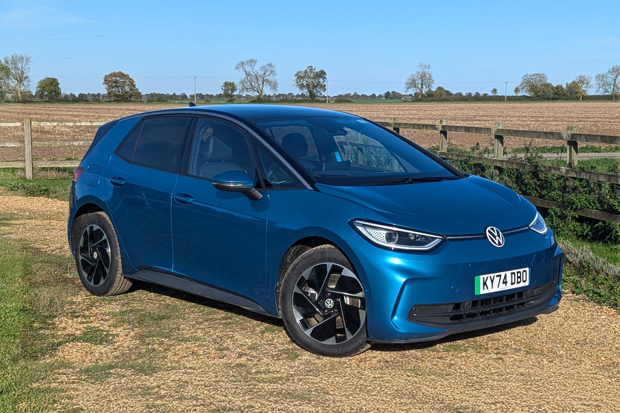
Specifications: Volkswagen ID.3 Pro Match 58kWh
Report 1: Volkswagen's smart EV joins the family
Volkswagen's popular small family EV has had a refresh - does it make a difference?
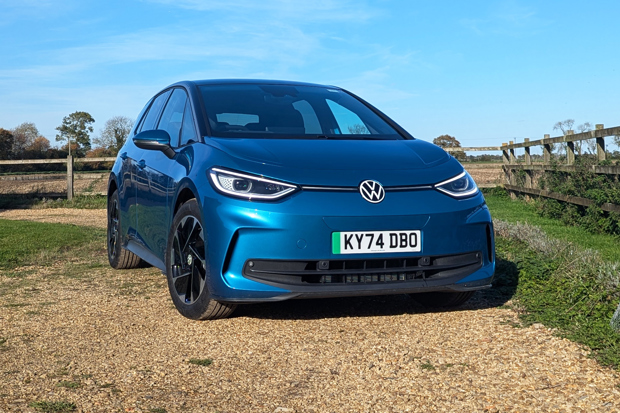
Date: 31 October 2024 | Current mileage: 310 | Claimed range: 269 miles | Actual range: 240 miles
The ID.3 wasn’t Volkswagen’s first attempt at an electric car, but it was the first model the company took really seriously. In the past, Volkswagen had dabbled in electric vehicles with models like the Volkswagen e-Up and the Volkswagen e-Golf, along with a few plug-in hybrids.
However, the VW ID.3 marked the first time Volkswagen went all-in on an EV, putting most of its chips on electric technology and setting out to create something as impactful as the VW Beetle or Golf - this time designed solely as an EV from the ground up.
Arguably, Volkswagen had been slow to embrace EVs until this point and the company moved quickly to get the VW ID.3 into production. In hindsight, perhaps a little too quickly, as the rush resulted in a car that was almost great but was held back by some rough finishes and reports of software glitches from owners.
With a good car trying to break through and only being hindered by issues that needed time and polishing to perfect, it was no surprise that Volkswagen opted for an early refresh of the ID3. Facelifted models began appearing from spring 2023 onwards.
You’d be hard-pressed to spot the exterior changes, though. Aside from subtle tweaks to the front and rear bumpers and the addition of a few new color options, not much has changed on the outside.
On the inside, however, the improvements in attention to detail are much more noticeable. The updated VW ID.3 features double-stitched leather on the dashboard and doors, backed by soft foam, replacing the hard plastic of the original version.
Then there’s the much-discussed software, which controls everything from air conditioning and navigation to charging details and more advanced settings. Volkswagen has fully overhauled the software, both in terms of user interface and backend performance. A new, larger 12.9-inch central screen replaces the previous 10-inch version with fiddly buttons, offering a significantly improved user experience.

Regarding batteries, the VW ID.3 has offered a range of options since its launch, balancing price and range. Initially, a 45kWh version was available, but this has since been discontinued, leaving the choices of 52kWh, 58kWh, and 77kWh battery packs.
If you opt for the range-topping GTX "hot hatch," that capacity nudges up to 79kWh. Depending on the battery choice, the range varies between 240 and 369 miles.
We chose the ID.3 Pro Match paired with the 58kWh battery and a 204PS motor. This mid-range option provides a good balance between usable range and affordability.
New prices start from a little over £30k, with this version priced at around £38,500. There are often attractive finance offers (including 0% interest) and dealer discounts, making it possible to secure a reasonable monthly payment on a PCP (though be mindful of the final balloon payment).
However, if that’s still too pricey - and let’s face it, it’s a significant amount for a hatchback - used models are becoming quite affordable. At the time of writing, early VW ID.3 examples were available for just over £12,000, with PCPs of under £150 per month. That’s cheap enough for buyers to start running the numbers before changing their next car.
For those who can charge at home using cheaper overnight tariffs and have the right driving patterns, the VW ID.3 presents a cost-effective way to own and drive a stylish, modern small hatchback.
That’s why we’re running this ID.3 for the next six months. We want to get to know this model better and provide an honest perspective on what it’s like to live with - from charging at home and using public charging points to understanding its real-world range and assessing whether it could be a cost-effective choice for you.
We recognize that EVs aren’t for everyone - some people may find them unsuitable for their needs right now. However, it’s possible that even if an EV wasn’t on your radar the last time you bought a car, it might be worth considering now.
Report 2: Putting on the miles and putting in the charges
The UK's charging infrastructure is finally improvingly - and quickly - as Dan discovers
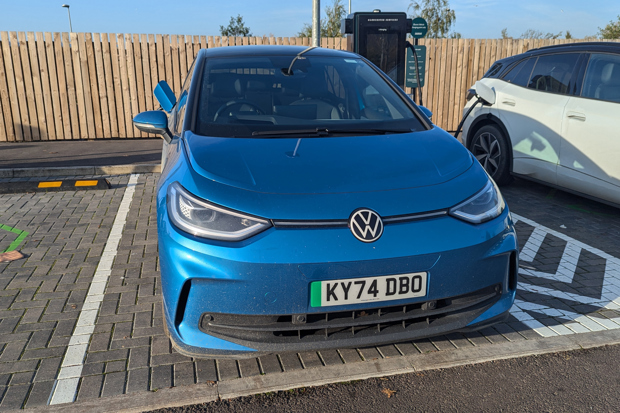
Date: 20 November 2024 | Current mileage: 1045 | Claimed range: 269 miles | Actual range: 240 miles
I’ve been driving an EV of one sort or another as my regular car for the past four years and before that would drive them from time-to-time. Most of my charging is done at home with a Zappi 22kW fast charger and use of solar panels and cheap overnight/flexible electric tariffs to keep the costs as low as possible - factored into the solar panel calculations would be the savings on petrol/diesel costs.
But I also do a decent number of longer drives that require using rapid and ultra-rapid chargers and this is where I have seen a huge change, not just over the long term - four or five years - but also in the last 6-12 months.
Things are moving quickly and whereas before I’d look for 50Kw chargers - and be pleased when I found them - chargers offering 75kW-150kW are now springing up all over the place and finding seems to be getting easier and easier.
It’s anecdotal, but I’ve found myself using Zapmap a lot less to hunt them down and there are just … there. That shouldn’t be seen as a dig at Zapmap, which remains a must-have app for every EV driver.
It’s backed up by the data. In 2024, the UK experienced a significant expansion in EV charging infrastructure, adding over 20,000 new public charge points - a 38% increase from the previous year. That included 4353 rapid or ultra-rapid charge points, marking a 28% increase compared to the 3411 installed in 2023.
The spread of chargers is getting better too. Just a few years ago, a disproportionate amount were being installed in and around London, with the rest of the country left behind. Now the coverage is getting better with even smaller towns and villages getting their own fast chargers. That said, there is still much more work to do.
This has helped to alleviate one of the stumbling blocks to EV take-up - the dreaded range anxiety and the amount of time you’re parked up to charge. With one of the rapid chargers, I’m able to get the ID.3 from almost empty to 80% in just over half an hour or less and a full charge within 45 minutes.
That makes a huge difference. It not only makes it easier to live with, but lower range cars with smaller batteries suddenly aren’t so much of a problem. If they can be quickly and easily charged, you don’t necessarily need that bigger (more expensive) battery.
I’ve already got a few longer trips under my belt in the ID.3 in the weeks that I’ve been running it. One took me to Minehead for a weekend away. The less said about the weekend, the better, but from my house, that’s a 460 mile round trip.
I’m currently seeing a range of about 240 miles from the ID.3, so in theory, that’s enough to get there, charge once, and come back again. But I did something a little different. I left with a full charge and then fully charged again at Gloucester Services, which is 130 miles down the road.

If I’m going to the west country, I always use Gloucester Services as a stop-off. Like its more famous sister site Tebay in the north west, it’s a very well considered and very well run site with a farm shop vibe, good food and clean and modern facilities.
And that applies to chargers too. Not only is there a good spread of fast chargers, but they also advertise the price per kWh on the way in, so there are no surprises at the charger. Why aren’t more services doing this? It not only gives reassurance on the price, but also gives a bit of reassurance that when you turn up the chargers will be working too. The logic being if they’ve taken the time to advertise the charger and cost, they’re going to want you to use it.
Anyway, by the time I had grabbed some food and a cup of tea in the services, the 150kW charger had got the battery back to full in well under half an hour. And at 64p/kWh, it was the cheapest ultra rapid charge I’ve seen for a long time.
The return trip saw me make a stop here again and do the same. It was further confirmation for me that longer journeys in EVs are getting much easier than they were just a few years ago and being able to charge quickly means you don’t necessarily need that bigger battery.
On the ID.3, for instance, the price difference between the 58kWh battery, which I have, and 77kWh battery is more than £4000 - so that makes a substantial difference if you only occasionally do longer trips and know that charging will be quick and easy.
Report 3: ID.3 - an insider's view
With a few thousand miles covered, how is the ID.3 stacking up form behind the wheel?
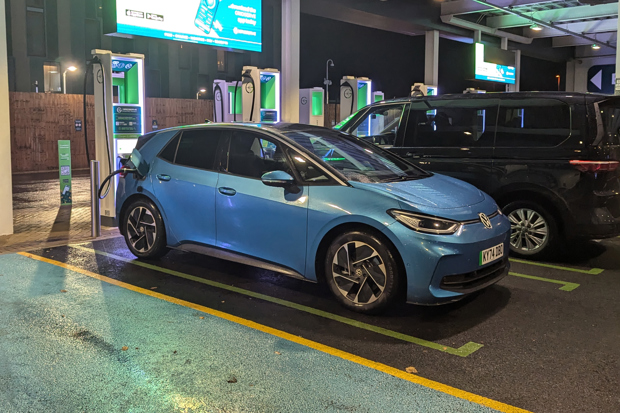
Date: 16 December 2024 | Current mileage: 2198 | Claimed range: 269 miles | Actual range: 225 miles
With more than a few thousand miles under my belt with the Volkswagen ID.3, I’m really starting to get familiar with it from behind the wheel. And that means there’s a bunch of details that I’m really beginning to get impressed with. And a few areas that I think could be improved.
In my first update, I mentioned that the software and infotainment had benefitted from a major upgrade and the addition of a larger screen. For me, this has transformed the behind-the-wheel experience, as all the key information is clearly displayed and there’s space to highlight other options.
Coupled with Android Auto (Apple Carplay is also available), it's something of a seamless experience with every important app just a voice command or button push away. What I love about Google Maps (which is so good, I tend not to use manufacturers’ built-in systems) is that it not only offers a great user experience, but brings in your search history from your phone or desktop - that saves time if you’ve recently been researching a trip.
While Google Maps takes the lion’s share of screen space, other apps get chunks of screen real estate too, so you have a good sense of where you’re going, what you’re listening to (if anything, but Amazon Music, Spotify and Audible all connect effortlessly) and what the car is doing.
If a Whatsapp or text message arrives, this can be read aloud by the car on the move and you can give a voice-controlled reply. I find that the reply function is a bit hit-and-miss with some words misinterpreted if you don’t speak clearly and slowly enough.
But the on-board software has offered-up a few surprises too, with the screen going ‘spooky’ at Halloween, festive at Christmas and marking literal milestones along the way (see pics below) when you hit certain mileages. All completely unnecessary, of course, but this ‘gamification’ of driving has brought a few surprises over the weeks and a few smiles.

This VW ID.3 is fitted with a heads-up display. I’m generally not a fan of these, as they’re often too distracting, not positioned correctly and don’t give the information that you actually need.
However, the system on the ID.3 is pretty good and, impressively, is in part animated. That’s designed to grab your attention at key parts of a trip.
So, for instance, while it will show what speed you're doing throughout the trip, when you’re getting closer to your destination or the battery is running low, these warnings will be projected onto the windscreen as large icons that then fade. There really is no way to miss them and I have found them to be more useful than the equivalent on the dash-mounted screen.
Now onto a few things that I still think the VW ID.3 misses the mark on. You have to remember that Volkswagen tore-up its way of doing things when bringing its latest generation of EVs to market and didn’t bring much across from its conventionally powered cars - if at all. That includes some of the basics, like buttons and switches.
So you’ll find that the steering column stalks which on the right-hand side operate the drive system and on the left-hand side operate the lights and wipers are entirely different to the Golf. This is a shame, as those on the VW ID.3 are a bit fiddly - that left-hand one in particular, which in my opinion is trying to do too much.
The washer for the windscreen is a push-button on the end of the stalk and for the rear screen it’s a button on the top that needs to be flicked to the left. The issue is that the force you need to operate them means it’s all too easy to end up flashing the lights or switching an indicator on, as that stalk operates everything.
It’s only a small gripe, but that stalk gets used on every trip to indicate, operate lights and clean the windscreen, so it gets an out-sized level of attention and if there’s a niggle, that’s amplified too. But it isn’t a deal breaker and as the miles pile on, it’s something that I’m beginning to adapt to.
Report 4: ID.3 - Winter's reckoning
Cold temparatures and dark mornings - how does the ID.3 stack up against the elements?
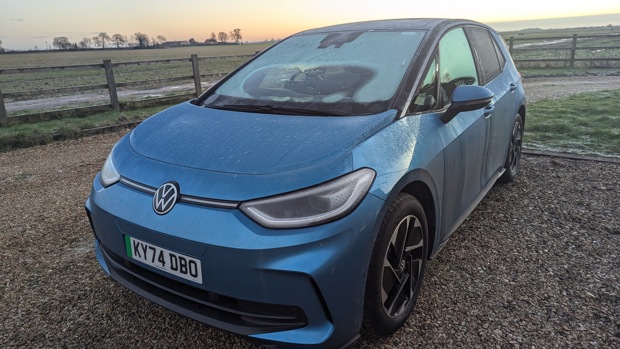
Date: 14 January 2025 | Current mileage: 4186 | Claimed range: 269 miles | Actual range: 215 miles
For me, the real test of an EV comes in the winter. On the negative side, cold temperatures means the range can take a walloping, using public chargers in the cold and dark can be uncomfortable and there’s little in the way of sunshine and daylight hours if you’re able to top up with solar.
But there’s a few areas where an EV comes into its own in the colder, darker months. And, as this isn’t my first Winter with an EV, it’s been good to see how the ID.3 performs from both points of view.
Firstly, the big one - range. My ID.3 arrived in October and I was happily getting 240 miles from it with the temperatures above 10 degrees. But since we’ve hit December and January, that has come down to 200-220, depending on how cold the temperature is and how hard the heater is working. That’s a decent chunk lopped off the range and means on some trips adding a stop to recharge when previously it could be done on a single charge. Temperature changes are one of the quirks that you have to get used to with an EV - it’s just a fact of life. EV batteries have reduced range in winter due to colder temperatures affecting battery chemistry, energy demand, and vehicle efficiency. Lithium-ion batteries rely on chemical reactions to generate power, which slow down in the cold, reducing efficiency and available energy. Additionally, EVs must use battery power to heat the cabin, seats, and windows since they lack an engine's waste heat, further draining the battery. Cold temperatures also stiffen tire rubber, increasing rolling resistance, while denser cold air creates more aerodynamic drag, especially at motorway speeds.

On really cold mornings, I precondition the cabin temperature, warm the seats and steering wheel and battery while the car’s plugged in. That helps to get the car warmed up and ready to go, while not eating into precious battery range.
And that brings me onto one of the things I love about having an EV in the Winter - the ability to set a timer to warm the car up in the mornings and de-frost while I’m still asleep. The ID.3 makes this super-easy with an simple-to-access menu that lets you set a time and which dates you want to warm the car up on. It means I haven’t once had a morning of scraping ice or being late while the car defrosts once. This hasn’t been a particularly harsh or gloomy Winter, either, and there have been plenty of bright days - the full length glass roof on the ID.3 makes it easy to appreciate the sunlight when it’s around - at this time of year every hour of sunlight is a bonus.
It may not have been an especially harsh Winter, but it has been a mucky one. The roads seem to have been especially filthy where we are this year, out in the sticks and travelling on rural backroads every day. The mucky roads are down to a combination of mud (thanks, tractors) and road salt, as the temperatures have remained pretty low through the start of the year. It’s meant that the car has been ‘treated’ to a fine spray of this mixture every time it's been out - and there’s no getting away from it.. This normally means that a reversing camera is out of action for a few months thanks to an accumulation of all that road gunk. Not so with the ID.3 - the camera is niftily integrated into the rear logo / boot opener.

Put the car into reverse, the logo opens up and exposes the camera. The rest of the time it’s concealed and, importantly, out of the way of the muck on the roads. While not unique, this is a clever bit of design. So many other models have a camera that’s open to the elements, which can limit its usefulness in these colder, darker, murkier months.
Report 5: ID.3 - At the pumps (no, not that sort)
Does this ID.3 come with a hidden piece of kit?
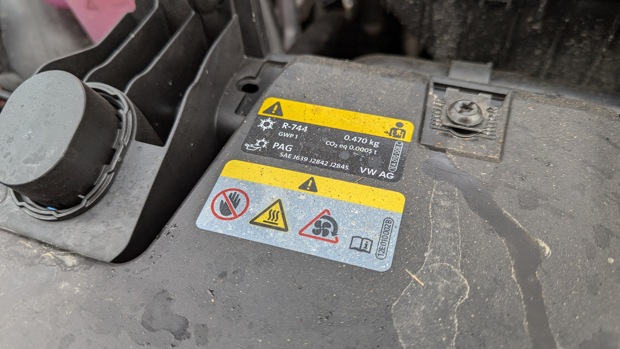
Date: 12 February 2025 | Current mileage: 6786 | Claimed range: 269 miles | Actual range: 215 miles
There’s something of a hidden feature in this VW ID.3 and one that could go completely unnoticed if you’re a used buyer. As a new buyer, you’ll know all about it, as it’s an option that adds the thick-end of a grand to the car’s price.
I’m talking about a heat pump.
If that means nothing to you, don’t worry, you’re not alone. In fact, it’s a relatively new thing to find on a car and as it’s so hidden away and there’s no indication of it when you scroll through the car status screens, that you wouldn’t know it was there. Or what the benefits - if there are any - are.
So, what is a heat pump and how does it work in a car? A heat pump is a climate control system used in electric vehicles that is said to be highly efficient. It’s designed to reduce the energy required to heat the cabin, thereby preserving the vehicle’s driving range, especially in colder weather.
Unlike traditional resistive heaters, which directly convert electricity into heat, a heat pump transfers existing heat from one place to another. This makes it significantly more efficient, as it relies on the movement of heat rather than generating it outright.

In the Volkswagen ID.3, the heat pump system operates in a way that is similar to a reverse air conditioner. The process starts by collecting residual heat from multiple sources within the vehicle, including the electric motor, power electronics and even ambient air. Even in cold conditions, some heat energy is available in the outside air and the ID.3’s heat pump is engineered to capture this efficiently.
Once this heat is collected, it undergoes a critical transformation. The system compresses the refrigerant gas within a closed loop, significantly increasing its temperature. This is a classic principle of thermodynamics: when you compress a gas, it heats up.
The heat pump then uses this high-pressure, high-temperature refrigerant to transfer warmth to the cabin via a heat exchanger. The result is a stream of heated air for the interior without the massive energy drain typical of conventional resistive heaters.
This method of heating is particularly effective in cold weather, where traditional EV heating systems can draw a substantial amount of power, potentially reducing the vehicle’s range by 20-30% or more. By reducing the energy required for heating by up to 40% in certain conditions, the heat pump can make a significant difference in the real-world usability of the car.
In addition to cabin heating, the heat pump also supports the ID.3’s battery preconditioning system. This means it can warm the battery while the car is still plugged in, optimizing battery performance before you even start your journey. This is crucial for maintaining consistent range and power output in colder conditions.
However, it’s not without its challenges. The effectiveness of the heat pump diminishes as outside temperatures drop well below freezing, typically below -10°C, where it struggles to find enough ambient heat to work efficiently. In these situations, the system may rely more on traditional resistive elements to maintain cabin comfort, reducing its overall efficiency advantage (source: Volkswagen UK).
If you’re buying a used ID.3, how do you tell if it has a heat pump?

- Check the Refrigerant Sticker:
Open the bonnet and locate the refrigerant information sticker, found near the front of the engine bay. If the sticker indicates R744 (CO₂), the vehicle is equipped with a heat pump. If it shows R1234yf, the heat pump is not present. - Visual Inspection:
Under the bonnet, vehicles with a heat pump will have additional components related to the system. By comparing your vehicle's setup to images of ID.3 models with and without heat pumps, you may identify the presence of these components. - Consult Vehicle Documentation:
Review the original sales invoice, build sheet, or vehicle specification documents. These should list optional equipment, including the heat pump if it was selected at the time of purchase. - Use the Vehicle Identification Number (VIN):
Contact a Volkswagen dealer and provide your vehicle's VIN. They can access the build information and confirm whether a heat pump was installed
Report 6: ID.3 - A tariff war
Time to look at the trade deficit that I have with my electricy supplier.
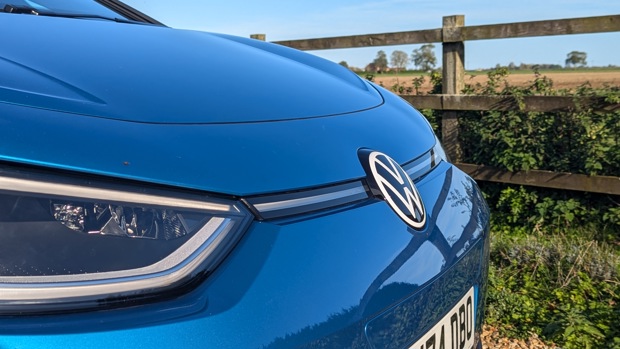
Date: 12 March 2025 | Current mileage: 7911 | Claimed range: 269 miles | Actual range: 215 miles
You can't look at the news or switch on the radio at the moment without hearing the word tariff. And I must admit, they've been on my mind too. But rather than the planned 'retaliatory' tariffs being suggested by the White House, I'm thinking much closer to home - literally.
A big part of owning an EV is keeping an eye on what's happening with electricity prices and tariffs. After all, the lower you can drive down costs, the cheaper every mile you drive is. I have decent solar generation (~12.5kWh), which means from Spring to early autumn, I can usually generate enough power to run the house and fully charge a car every couple of days - sometimes a bit less if it's particularly sunny, sometimes a bit more if it's particularly cloudy.
But, from late Autumn to early Spring, although there's still some power generated, there isn't enough to charge the car. This is generally where keeping an eye on electricity prices and being flexible when you can charge pays off. I’m with Octopus Energy and use their Agile Octopus tariff. This isn’t a tariff that works for everyone and takes a bit of getting used to. That’s because instead of there being fixed rates, the rates change every 30 minutes, based on what the wholesale market is doing. You’re given the rates 24 hours in advance, which means you can plan to do things like charging the car at cheaper times. As a rule of thumb 4pm-7pm is the most expensive time of day and nighttime is cheapest - though this isn’t always the car.
Last year, I was able to play the system - particularly over the Winter and made some significant savings. There were a number of big storms in the early part of 2024 which, coupled with an overall drop in electricity prices, meant that there was lots of very cheap energy about (a few pence per kWh) and on some days I was even being paid to use electricity - which I put to good use by having the car (and anything else I could find…) on fast charge.


So I was expecting more of the same this Winter … but it hasn’t quite worked out that way. Weather conditions have been similar (there have been plenty of blustery days) and I have been incredibly patient … but prices have remained stubbornly high on this tariff. To the point where in the evenings it could cost as much as £1/kWh. Now, this wouldn’t be too much of an issue if it was a one-off and balanced out with low cost periods, but it hasn’t been. And that kind of pricing is eye-watering … if I was to charge the ID.3 at those prices, I’d be paying more than the services, where it’s generally 75-80p/kWh. Lunacy. Even the lows have been high - around 25p/kWh, which means I’m thinking of moving to a more conventional tariff - something like Octopus Go where the costs are fixed and overnight charging is 9p/kWh. Octopus is great when it comes to switching tariffs and if you’re all set up, you’re switched almost immediately. And neither am I locked-in. I’ll keep an eye on what Agile Octopus is doing and can easily switch back if those supercheap periods make a reappearance.
We’re also not too far away from the Spring Equinox and those lighter, longer days, too. This makes a big difference. At the very least I will be able to offset some of the charging costs with “free” electricity and on clearer, brighter days charge the car entirely for free. Should Agile Octopus become worthwhile again, I can be a little more clever with how I use solar. I get paid 16p/kWh for exporting to the grid, so if Agile allows me to buy below this rate, I will charge the car from the grid as much as I can, export the generated electricity, and pocket the difference.
Is it worth the bother? At the moment, the range on the ID.3 is around 200 miles and I’m getting around 3.5 miles per kWh. That 200 miles (approx 57kWh) can cost nothing (or even paid to charge) at the lower end of tariffs, around a fiver when it’s 9p/kWh, a tenner at 16p/kWh and about £14 at 24p/kWh. I’ll leave you to do the maths for when it hits £1/kWh.
For comparison a diesel or petrol-powered car doing 45pmg and a fuel price of £1.35/litre costs around £27 for 200 miles.
